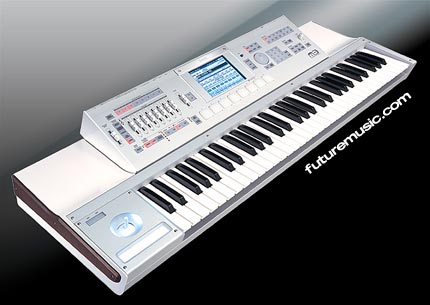Korg Introduces New M3 Workstation
Korg has risen from its stupor to introduce the new M3 Workstation. The M3 heralds the third generation of Korg Workstations and features a number of innovations distilled from the flagship OASYS including the new EDS (Enhanced Definition Synthesis) sound generator derived from the HD-1 engine design, the advanced second-generation KARMA functionality, and the multi-purpose control surface. Adding innovations such as the new concept of “virtualized hardware” that allows an even closer integration with DAW systems, Drum Tracks which provide a instant groove to play along with, and the new “Korg Komponent System” concept that facilitates more flexible system construction, the M3 music workstation/sampler opens a new and exciting page in music making, and is the workstation that rightfully deserves to wear the “M” that started it all.

The M3 features a newly developed “EDS” sound generating system based on a new chip design that was developed in parallel with the HD-1 engine from the flagship OASYS. It takes full advantage of the M3’s 256 Mbytes of PCM source material which is a veritable “best of” from the OASYS. Using Korg’s advanced voicing technology, the 1,028 multisamples, 1,606 drum samples, dual oscillators, four-level velocity switching/crossfading/layering, and stereo sampling allow for an enormous range of high-quality, detailed, and expressive sounds.
The filter section, a vital part of the sound-creation process, lets you simultaneously use two resonant filters for each oscillator, and can be configured in series or parallel. Four filter types are provided: low-pass, high-pass, band-pass, and band-reject. The all-important effect section provides up to five Insert effects, two Master effects, and one Total effect. In addition to great chorus/flanger/phasers, delays and reverbs, the 170 effect types include dynamics-type effects such as compressor and limiter, amp modeling and speaker simulation effects using Korg’s proprietary “REMS” modeling technology, and evocative effects like the Grain Shifter and Talking Modulator.
Combination Mode is where multiple Programs can be freely assigned as splits and layers across the keyboard, including velocity switching and cross-fading for complex and expressive sounds. Sounds can be delayed either by time or by tempo, even when you release a key, allowing you to create sophisticated rhythmic soundscapes and performance effects. Monophonic sounds can be forced to be polyphonic, or vice-versa, and you can select only one of the oscillators if desired. For the more adventurous musician, each timbre can even use a different scale or tuning! The M3 allows for sixteen timbres at the same time, along with a Drum Track, up to four KARMA Modules, multiple effects and much more. Each timbre has dedicated 3-band EQ for getting the perfect mix, and a powerful Tone Adjust setup for detailed in-context sound shaping.
The second generation KARMA functionality that first appeared on the OASYS and received acclaim from artists and users world-wide is also provided. KARMA is the inspiring, real-time phrase generator that can help you play everything from natural instrument gestures like intricate finger-picking, strumming and harp glissandos, to complex cascades of notes, dance-riffs, gated and chopping effects and “improvising” drum grooves. The inspiration that KARMA offers, coupled with the unheard-of phrase variability is second to none.
The M3’s Open Sampling System lets you sample and resample in any mode to produce new remixed combinations of sounds and effects, or to capture full performances “In-Track” within the sequencer. Cutting-edge editing tools include Time Slice, Time Stretch, Crossfade Looping, Rate Change and Normalize.
The sequencer that’s at the heart of the M3’s song production is an intuitively-understandable 16-track design that holds up to 128 songs and 210,000 notes. The new high timing resolution of 480 PPQ captures every nuance and detail of your performance. Three-band EQ per track provides detailed sound-shaping, as does the Tone Adjust sound “tweaking” function.
In addition to being a highly-developed music workstation, the M3 is also able to closely integrate with your computer. By connecting the M3 to your computer via USB and using the included stand-alone “M3 Editor” software, you can edit sounds and settings from your computer.
The M3 music workstation/sampler is available as a lineup of four models: 61-key, 73-key, and weighted 88-key models, as well as the module-only M3-M. The 61-key and 73-key models use a proprietary new semi-weighted synth action keyboard developed by Korg for great playing feel and expressive aftertouch response. The 88-key model features the RH3 (Real Weighted Hammer Action 3) keyboard that reproduces the playing sensation of a grand piano, in which the low range has a heavier feel, with the touch becoming lighter as you play upward on the keyboard, allowing superb response to fine movements of your fingers. The M3 music workstation/sampler introduces the new Korg Komponent System, featuring detachable keyboard and sound generator sections. The 61-key model lets you mount a RADIAS-R analog modeling synthesizer instead of the M3-M sound generator, the 73-key model lets you mount the M3-M together with a RADIAS-R analog modeling synthesizer, and the 88-key model supports the combination of M3-M and RADIAS-R or even mounting two M3-M units simultaneously. Of course you can detach the M3-M sound generator and use it as a sound module, giving you great flexibility for constructing the system you need whenever you want.
The Korg M3 series instruments are slated to start shipping in June 2007 with pricing to be announced. More information on the Korg M3 Workstation.






